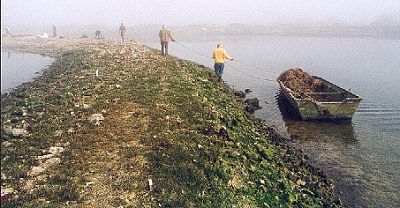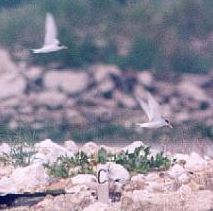Islands in Langstone Harbour
RSPB Islands
There are five islands with long-established names in the harbour, North Binness, South Binness, Long Island, Baker's Island and
Round Nap Island. Looking from Portsdown Hill, the most obvious island is North Binness,
with oak woodland and gorse.
Along with extensive areas of inter-tidal mudflats, they are managed as a
nature reserve by the RSPB. Seabirds breeding on
the islands during the summer include Black-headed and Mediterranean Gulls, and Common, Sandwich
and Little Terns. The harbour is the largest nesting site for "Med" Gulls in the UK, with 46
pairs in 2001. 2002 was not so successful, with 19 pairs raising 11 young, though 2003 is an improvement, with 33 pairs raising 18 young. 2004 was a good year up until a storm in late June. The Little and Common Terns were badly affected, with very few young surviving (source : RSPB warden).
At other times the islands become high-water roosts for seabirds which are either
stopping off during migration or are spending the winter in the harbour. No landing by humans is
allowed except on the southern end of Long Island, and then only during daylight. Volunteers
from the Friends of Langstone Harbour have occasionally been involved in helping to maintain
South Binness Island for breeding Little Terns by relocating piles of seaweed, although nature
has a habit of re-arranging things anyway.
Little Tern Island
 Hayling Oyster Beds (Grid ref. SU714035) have been the focus of much effort recently by Havant Borough Council and
the Friends of Langstone Harbour to improve their wildlife value. In particular, Little Terns
have benefitted from this work by gaining their own island to breed on. It is kept free of perennial vegetation by weeding before the terns arrive in April. The island was initially more popular with the terns than the more remote RSPB Islands. Good views can be had of the birds from the shore, without disturbing them.
Hayling Oyster Beds (Grid ref. SU714035) have been the focus of much effort recently by Havant Borough Council and
the Friends of Langstone Harbour to improve their wildlife value. In particular, Little Terns
have benefitted from this work by gaining their own island to breed on. It is kept free of perennial vegetation by weeding before the terns arrive in April. The island was initially more popular with the terns than the more remote RSPB Islands. Good views can be had of the birds from the shore, without disturbing them.
 In the right-hand picture is one of a number of posts marked with a letter, useful for keeping track of where the birds breed on the island. The first attempt at raising young in 2002 was a disaster, as the nests were washed away by severe weather. Undeterred, some birds bred successfully. 2003 has been even worse, with possibly only one fledged (source : RSPB warden). 2004 wasn't any better, with high tides in early June, and a storm later on.
In the right-hand picture is one of a number of posts marked with a letter, useful for keeping track of where the birds breed on the island. The first attempt at raising young in 2002 was a disaster, as the nests were washed away by severe weather. Undeterred, some birds bred successfully. 2003 has been even worse, with possibly only one fledged (source : RSPB warden). 2004 wasn't any better, with high tides in early June, and a storm later on.
John Shillitoe was employed as a summer warden by Havant Borough Council and Hampshire Wildlife Trust in 2005. Sadly, results for the year were again poor. Little Tern, Common Tern and Black-headed Gull all failed to establish nests on the island. Inspection of egg-shells indicates that rats found their way onto the island and ate eggs laid early in the season. This and poor weather were enough to deter the birds from further attempts at breeding.
Jason Crook has been the summer warden for 2006, assisted by a team of volunteers. There was a problem with rats early on, but about a dozen young have been reared successfully, with a late end to the breeding season. Stray dogs are a recurrent problem, attacking young birds on the shore and occasionally swimming over to the island and causing havoc.
To improve the birds' chances of breeding, the floating raft has again been anchored next to the island, but seems to be used only as a perch.
The Oyster Beds and some nearby land has been designated as the West Hayling Local Nature Reserve.
Back to Sites
 Hayling Oyster Beds (Grid ref. SU714035) have been the focus of much effort recently by Havant Borough Council and
the Friends of Langstone Harbour to improve their wildlife value. In particular, Little Terns
have benefitted from this work by gaining their own island to breed on. It is kept free of perennial vegetation by weeding before the terns arrive in April. The island was initially more popular with the terns than the more remote RSPB Islands. Good views can be had of the birds from the shore, without disturbing them.
Hayling Oyster Beds (Grid ref. SU714035) have been the focus of much effort recently by Havant Borough Council and
the Friends of Langstone Harbour to improve their wildlife value. In particular, Little Terns
have benefitted from this work by gaining their own island to breed on. It is kept free of perennial vegetation by weeding before the terns arrive in April. The island was initially more popular with the terns than the more remote RSPB Islands. Good views can be had of the birds from the shore, without disturbing them.
 In the right-hand picture is one of a number of posts marked with a letter, useful for keeping track of where the birds breed on the island. The first attempt at raising young in 2002 was a disaster, as the nests were washed away by severe weather. Undeterred, some birds bred successfully. 2003 has been even worse, with possibly only one fledged (source : RSPB warden). 2004 wasn't any better, with high tides in early June, and a storm later on.
In the right-hand picture is one of a number of posts marked with a letter, useful for keeping track of where the birds breed on the island. The first attempt at raising young in 2002 was a disaster, as the nests were washed away by severe weather. Undeterred, some birds bred successfully. 2003 has been even worse, with possibly only one fledged (source : RSPB warden). 2004 wasn't any better, with high tides in early June, and a storm later on.